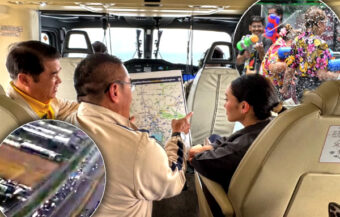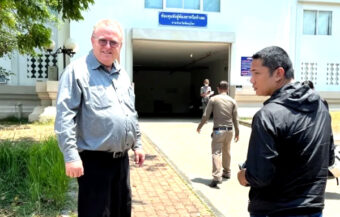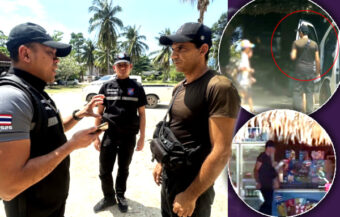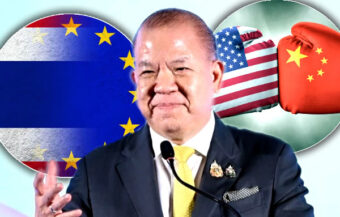An extended range of concerns has emerged to hamper the confidence seen last month after the Prime Minister’s reopening announcement on October 11th. These include a loss of enthusiasm and momentum among foreign tourists even as arrivals continue to be processed, the emergence of real inflationary pressures, labour shortages and problems in the country’s key export markets of the United States and China. This sentiment has been confirmed this week by a University of the Thai Chamber of Commerce (UTCC) survey which shows rising consumer anxiety about the prospect of another COVID-19 wave falling on the kingdom.
There are fears that economic confidence and momentum is stalling as a key economic policy agency this week predicted the economy to grow by only 1.2% in 2021 with the Minister of Finance Arkhom Termpittayapaisith suggesting a 1% growth rate. This is still dependent on a strong economic recovery in the fourth quarter which is now being buffeted by a loss of confidence with fears growing about external economic factors outside Thailand and a possible resurgence of COVID-19 as seen in Europe and other western countries.
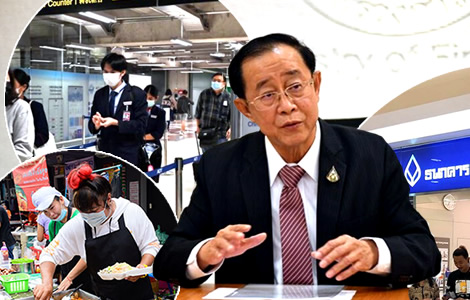
The Thai economy will continue to face headwinds until well into the second half of 2022 according to economic experts even after figures were published on Tuesday by the National Economic and Social Development Council (NESDC) which showed a lower than anticipated contraction in the third quarter of the year.
The country’s leading economic policy body now predicts that the economy will grow in 2021 by 1.2% approximately.
It comes after Finance Minister Arkhom Termpittayapaisith predicted, on Monday, a 1% growth figure for 2021.
In mid-October, the Fiscal Policy Office had predicted a 1.3% growth rate.
New problems emerging to thwart the economic recovery launched by the government in October
Nevertheless, this figure is still dependent on a strong performance from all economic engines in the final quarter of the year.
The recovery, which began in October with rising levels of consumer confidence, boosted by government expenditure and a broader reopening of the country to foreign tourism, is already facing issues.
These include the dangerous loss of momentum in the reopening to foreign tourism, problems emerging in Thailand’s two largest export partners, the United States and China and growing nervousness among consumers about the continued threat posed by the virus.
In addition to this, the prospect of rising inflation and oil prices has also made itself known to both consumers and business concerns.
Lower than expected GDP contraction in the third quarter announced by the top economic policy agency
On Monday, the National Economic and Social Development Council (NESDC) revealed that the economy had contracted by 0.3% in the third quarter following a reported 7.5% growth rate in the second quarter of the year although, with adjustments for seasonal factors, the economy also shrank in the second quarter of the year by 1.1%.
Central bank to lower GDP growth forecast as its attention turns to private sector debt management
The country’s GDP suffered a 2.6% contraction in the first quarter of 2021.
Indeed, towards the end of the third quarter, many analysts were predicting a possible GDP contraction for 2021 following a severe 6.1% setback in 2020.
September this year saw Thailand at its lowest point during the pandemic with a sinking economy
The third quarter downturn in the economy was caused by the Delta virus wave which saw the country again impose restrictions and curbs.
The quarter saw Thailand reach its lowest point economically in the crisis so far with the lower than expected contraction announced this week being attributed to prompt government support measures to prop up the most vulnerable and struggling small firms in August and September.
At the end of October, many financial analysts, Stock Exchange of Thailand (SET) experts and institutions such as the Kasikorn Research Centre revealed that profits from Thailand’s leading banks would see net profits fall by 42.5%.
This came from a sudden deterioration in core business income which saw non-interest fee income drop by between 6.5% and 9%.
This was despite a significant growth in bank credit advanced in 2021 which saw accounts receivable grow to ฿4.77 trillion in April 2021 from ฿3.18 trillion the year before and ฿5.12 trillion in July 2021 from ฿3.35 trillion the year before.
These advances were made at a lower than normal net interest margin with total non-performing loans predicted to surge up towards to 3.17% at the end of the third quarter.
Decision to reopen to foreign tourism and expanded stimulus efforts drove a turnaround from October
It has already been widely acknowledged that the decision to reopen the country announced by Prime Minister Prayut Chan ocha on October 11th was linked to a need to avoid a second year of economic contraction and to use foreign tourism to kickstart a recovery process.
The predicted growth of the economy for 2021 is still very much dependent on its performance in the last quarter of the year with the University of the Thai Chamber of Commerce (UTCC) this week predicting only 300,000 arrivals in the last two months of the year.
‘The Thai economy is expected to see a strong recovery in the fourth quarter of this year thanks to the country’s reopening early this month,’ explained Danucha Pichayanan, the Secretary-general of the National Economic and Social Development Council (NESDC) on Tuesday.
‘This year’s growth is estimated at 1.2% and 3.5 to 4.5% next year, boosted by the recovery in domestic demand and manufacturing production, following the improving Covid-19 situation and the progress on vaccine distribution, the return of domestic tourism after the easing of the international travel policy, and the expansion of exports.’
Exports to grow by 12% in 2021 but the sector needs more than 420,000 workers to power on into 2022
Exports which have been consistently growing since March, are expected to round out the year, up by 12%, after experiencing problems in the third quarter with factories impacted by the COVID-19 outbreak added to by ongoing problems reported, such as a shortage of shipping resources and the availability of labour in the industry.
Last week, the government revealed that Thailand’s manufacturing sector needs 420,000 additional migrant workers to help strengthen efforts leading to economic recovery.
Figures assume ฿130 billion in foreign tourism earnings in 2021 with only 85,845 visitors to October 31st seen across all of Thailand
The current projection for 2021 assumes an income generated of ฿130 billion for 2021 from foreign tourism or 6.6% of that achieved in 2019 when the country saw nearly 40 million foreign holidaymakers who generated ฿1.98 trillion.
Thailand is looking at achieving 350,000 to 400,000 visitors in total for or a maximum of 1% of the number seen in 2019.
The total number of visitors seen up to November 1st was 85,845 with problems with the Phuket Sandbox causing a drop in arrivals from the opening of that scheme on July 1st when 18,056 visitors entered Thailand in total for the month to only 12,737 in total for October 2021.
The government’s projected revenue works out at a total expenditure per visitor of ฿325,000 compared to an average spend of ฿49,500 for visitors in 2019.
This warrants further investigation and appears far higher than figures seen to date.
Indeed, at the close of the opening three months of the Phuket Sandbox scheme, despite initial figures showing expenditure per visitor close to ฿59,000, the average expenditure confirmed by the Tourism Authority of Thailand office in Phuket, at the end of the opening three months, was ฿47,619, 14.01% of which went on medical costs.
Domestic tourism receipts were only ฿12.34 billion for January to May even before the deadly third wave of the virus but are projected to recover in the fourth quarter.
Return of tourism in high volume numbers has yet to be seen with 2022 predicted at only 20% of 2019 peak
The normally bullish Tourism Authority of Thailand (TAT), in August this year, predicted domestic tourism revenues for 2021 at ฿540 billion with ฿85 billion in foreign tourism receipts.
Bright lights may be turned on again for foreign tourism as hated Certificate of Entry is to be axed
In the meantime, the government has projected a rise in foreign tourism income to ฿400 billion in 2022 which would, based on 2019 estimates for expenditure per capita, see 8.04 million visitors.
Most analysts are predicting that the kingdom will see at least 5 million visitors in 2022 providing the virus can be kept in check and the current reopening process is not reversed.
Thailand may yet face a long term problem in its quest to resurrect the all but dormant tourism industry which existed in September if the current reopening of the kingdom to foreign tourists fails to reach anything like the volumes seen in the past.
Warning from Pattaya hotel industry boss of a Chinese takeover, loss of income to the wider Thai economy
This virus has certainly proved in 2021 how reliant the wider Thai economy is on the country’s tourism industry and in particular, foreign tourism earnings.
Government targets growth of 4% in 2022 and must continue to prime the economic pump with stimulus
The government itself this week and the National Economic and Social Development Council (NESDC) accepted that strong fiscal stimulus to support what still is shaping up to be a slow and hard-fought-for recovery, will be required into 2022.
The economic policy body is predicting a growth rate of 3.5% to 4.5%. The Minister of Finance predicted 4% on Monday.
Economy climbing out ‘of a hole’, foreign firm’s confidence levels rose sharply during October
Mr Arkhom confirmed this on Monday when he outlined that the government would inject ฿3.7 trillion into the economy in the coming year including ฿3.1 trillion for expenditure and ฿300 billion in emergency loan funding.
The importance of government stimulus and continued borrowing to support the economy was also emphasised by Mr Danucha this week when he credited such support for the better than expected third-quarter GDP figure which only showed a marginal reversal despite setbacks on all fronts in the third quarter from rapidly declining tourist arrivals to an impeded export performance which meant that hopes for growth in exports of 15% this year had to be scaled back to 12%.
Exports are expected to rise by 5% in 2022 but already there are fears for both the US and Chinese economies
For 2022, exports are expected to rise by 5% although the world economy has been shaken in recent weeks by rising oil prices, dangerous geopolitical tensions and supply chain disruptions across the world.
This has been joined by the terrifying prospect of rising inflation being seen in western countries such as the United States which recorded a 6.2% inflation rate in October, the highest since 1990.
This will almost certainly mean a rise in US interest rates which may impact economic growth in what is Thailand’s largest export market.
Similarly, China, the country’s second-largest export market, has been experiencing unprecedented economic problems with what many analysts believe to be a growing likelihood of difficulties emerging from what looks like a property bubble on the verge of a crash.
House prices in 70 key Chinese markets fell by an average of 0.25% in October. This happened at the same time as a decline in the supply rate and new starts.
Exporters body is confident but has expressed concern about freight costs and the availability of labour
Thai exporters however remain optimistic with the President of the Thai National Shippers’ Council Chakkapat Chaiyasansaying revealing recently that he expects global demand to remain high or even improve.
‘In 2022, global demand is expected to return to normal and every country will keep sufficient inventory,’ explained Mr Chaichan. ‘Nonetheless, the council still believes Thai exports will continue to expand further in the year to come under the assumption that the baht averages 33 baht per US dollar, the oil price remains around US$85 a barrel, and the freight rates do not go too high.’
At the same time, industry leaders are warning about a shortage of labour in the manufacturing sector and also delays in businesses obtaining Value Added Tax refunds from the government which has had a severe impact on their ability to manage cash flows.
Inflation is not a key worry for Thailand in the short term but has already begun to have an impact
In a brief to the markets in October, Bank of Thailand director Chayawadee Chai-Anant downplayed inflation fears suggesting that Thailand was better positioned than most countries to deal with the situation.
However, the rising price of oil is expected by many economists to become a factor as the average Thai household spends ฿1,670 on oil products a month with the price, even in the medium term predicted to rise by 25% costing each family or household ฿340 or 1.6% of monthly expenditure.
The price of oil, by this summer, had risen by 65% from 2020 levels of $42.20 and since then has climbed by a further 30% although it has fallen back since hitting nearly $85 per barrel some weeks ago.
Higher oil costs add 1.6% to the average Thai family’s bills already with rises now seen in food prices
In a wider economic context, the rise in oil prices is expected to hit the profitability of a range of Thai companies including logistics and transport firms which face a 32% hike while the fishing industry will see a 19% hike followed by mining at 11%, chemicals at 9% and even higher costs in the building industry which is facing a 4% rise in material costs.
On Monday, The Prime Minister ordered the Ministry of Commerce into action to monitor and take urgent measures with reports of rising food prices.
Spokesman Thanakorn Wangboonkongchana said the Department of Internal Trade was being tasked with making efforts to keep the price of fresh food and ingredients down for the consumer.
Mr Thanathorn accepted however that the prices of farm products including palm oil, eggs and fresh vegetables had risen sharply.
‘The government has several programmes, including the co-payment scheme and blue flag shops selling low-priced food, to help keep down the people’s cost of living,’ he disclosed. ‘The government also plans a new round of registration for state welfare cards, to cover more people in trouble.’
Nervousness has crept into the economic outlook
The nervousness surrounding the economy which has emerged in the last week also coincides with a loss of momentum in connection with the reopening of the country to foreign tourism with bugs on the Thailand Pass system and an extension of the ban on nightlife and bars turning off many potential foreign tourists from visiting Thailand even though it looks like the government should exceed its own target of 200,000 visitors in the last two months of 2021.
A survey released, this week, by the University of the Thai Chamber of Commerce (UTCC) suggested rising unease about the economic situation in the light of the resurgence of the virus in Europe and the United States.
‘People are still cautious about spending because they are not confident whether Covid will be contained after the country’s reopening,’ explained Thanavath Phonvichai, the President of the institution.
The survey predicts that consumption will remain weak given the levels of uncertainty that still exist.
Join the Thai News forum, follow Thai Examiner on Facebook here
Receive all our stories as they come out on Telegram here
Follow Thai Examiner here
Further reading:
Economy climbing out ‘of a hole’, foreign firm’s confidence levels rose sharply during October
Another GDP contraction looms as Thailand tries to boost its economic fortunes by spending more
Government borrows more to bring the economy through an extended Covid 19 crisis with GDP flat
Officials switch to prioritising economic recovery as CCSA expected to agree a new Covid approach
Rising prospect of GDP contraction for 2021 may see government breach the legal public debt limit
Economic fears rising as Thailand faces a bigger crisis than 1997 with rising job losses and debt
Baht falling with confidence in Thailand waning as foreign tourism closure and virus drive funds out
Central bank to lower GDP growth forecast as its attention turns to private sector debt management
Loan bill passes but Thai economic prospects are not bright with a 1.8% 2021 GDP gain predicted
IMF urges government to loosen nation’s purse strings as finances tighten with the tax take down
Failure to pass the ฿500 billion borrowing decree could lead to the dissolution of parliament
Industry leaders and central bank all warn that foreign tourism must return to avoid a collapse
Fact – only 6,556 visitors arrived in Thailand last month compared to 3.95 million in December 2019
Desperate foreign tourism business concerns are clinging to straws as they try to survive the crisis
Challenge of the virus and closure to tourism leads to major long term changes in the Thai economy
Finance Minister says economy must pivot away from tourism with a switch to S-Curve industries
Strengthening baht predicted as investors bet on a reopening of Thailand to mass tourism in 2021
Thailand facing a credit crunch as 3rd virus wave craters the kingdom’s economic recovery plans
3rd virus wave now spells not just economic loss but financial danger as kingdom’s debt level rises
Still time to avoid lockdown says Health Minister as 3rd virus wave dwarfs all infections to date
Thai economy is still in reverse despite rising confidence and a virus threatening a 3rd wave
Reopening of Phuket still not officially approved although it is the ideal test for a broader move
Minister urged not to be afraid to borrow in 2021 as fears grow for a quick foreign tourism revival
Economy to rebound as the year progresses driven by exports and a return of mass foreign tourism
Door closing on quick foreign tourism return as economic recovery is delayed to the end of 2022
Fact – only 6,556 visitors arrived in Thailand last month compared to 3.95 million in December 2019
Desperate foreign tourism business concerns are clinging to straws as they try to survive the crisis
Finance Minister says economy must pivot away from tourism with a switch to S-Curve industries


